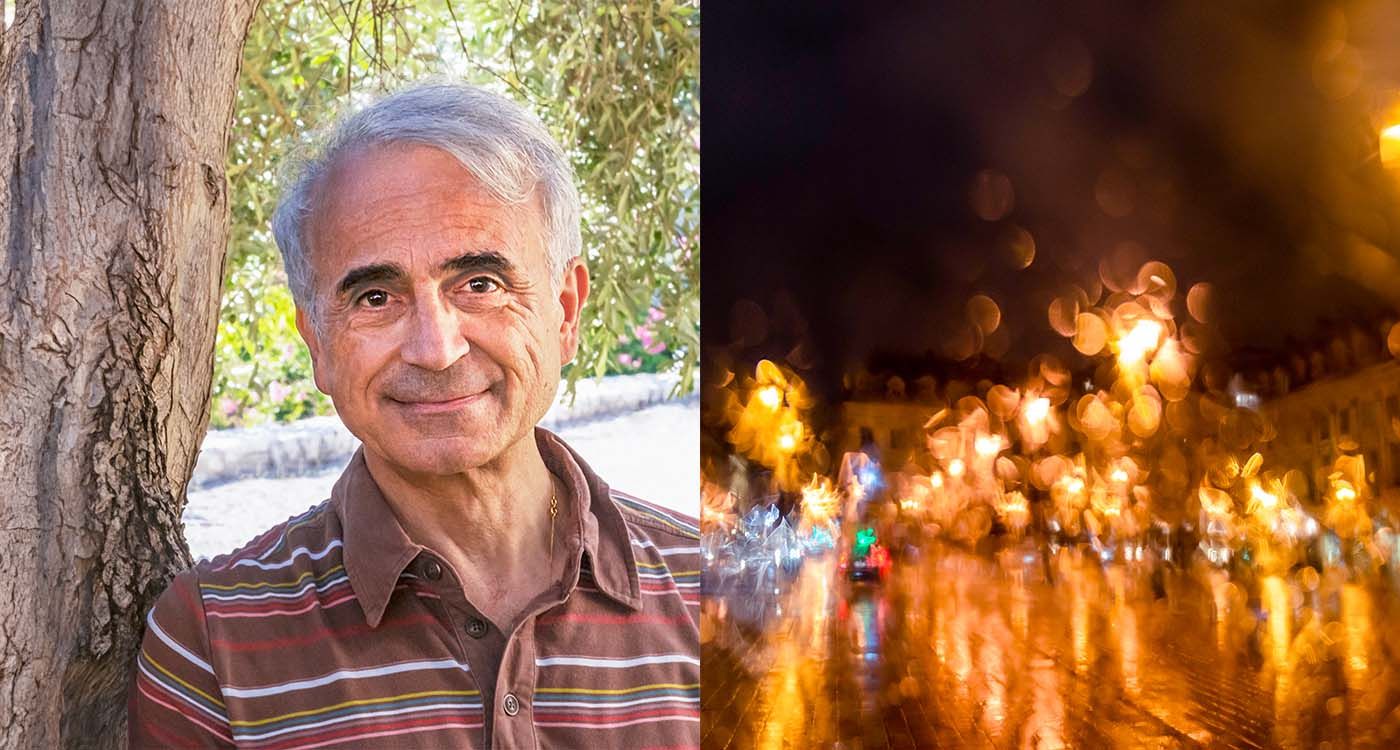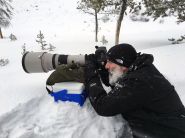
Under his ink umbrellas, Paris transforms. Robert Bared captures the spirit of the city in the rain, turning raindrops into prisms and puddles into mirrors of the sky. The photographer, who creates a world where visual memory and poetry meet on wet streets, opened up to This is Beirut.
Paris, the City of Light, is never more captivating than when draped in rain. The streetlamps transform into liquid stars, passersby become dancing silhouettes, and the asphalt becomes a mirror, reflecting and multiplying the world. This is the universe that Robert Bared, a Lebanese-born photographer who has called Paris home since 1975, has dedicated himself to capturing with exceptional sensitivity. Through his lens, the city is revealed anew, shrouded in a veil of water that turns reality into a dream and the everyday into a living masterpiece.
When asked about the roots of his photographic passion, Robert Bared traces it to painting. “My love for photography was born from painting,” he confides. His vision was shaped by years of academic study and research in art history and literature. “I have contemplated literary and artistic beauty since my youth, first through my studies and later through my research in literature and art history. I seek to define it, understand it, and grasp its challenges and impact.”
This quest for beauty almost naturally led him to photography. “About twenty years ago, I felt the need to capture it, and I did so through photography, the only visual medium available to me.” It was a visceral, almost inevitable urge that emerged after years of observation and theoretical analysis.
“My visual culture developed in layers, each shaped by distinct and recognizable influences. From an early age, my visual culture was marked by artists like Corot, Fragonard, and Daumier. In terms of urban landscapes, it was influenced by painters such as Turner, Whistler, Monet, and Albert Marquet.” His work, in fact, mirrors the same attention to light, reflections, and atmosphere that defines these great masters of painting.
It was only later that photography began to enrich his vision, naturally extending his pictorial sensibility. “In a second phase, my work was enriched by 'humanist' photography, especially the precise, imaginative, and sensitive styles of Doisneau and Cartier-Bresson.” The legacy of these great French humanist photographers is evident in his attention to silhouettes, postures, and the urban choreography that rain makes even more poignant.
Later, color introduced a new vibrancy to his work, adding a new dimension to his vision. “I then discovered American photographers like Harry Callahan, and later Saul Leiter, which marked the arrival of color in my photography.”
Reality Transformed Through the Lens
What distinguishes Robert Bared's photography is his remarkable ability to transcend the confines of reality. How does he capture the poetic, almost musical essence of urban scenes? “By distancing myself from reality,” he explains, “though never entirely abolishing it, as figuration seldom disappears from my photos.” This balance is key—it’s not about complete abstraction, but rather about transforming reality.
In his work, urban reality is subtly altered, yet never entirely erased. “Urban reality typically lingers in the background, offering me both graphic and chromatic material, or, in musical terms, rhythms and themes.” Like a composer, Bared rearranges visual elements into a visual score, where shapes and colors converse in an inner harmony.
This approach frees the viewer’s imagination, creating a unique resonance. “From that moment, there are no longer any barriers to our imagination or sensitivity. The landscape, more suggested than represented, creates a deeper echo within our inner worlds.” This approach mirrors that of the Impressionists and Symbolists, whose art is not to faithfully replicate reality, but rather to evoke emotions, memories, and sensations.
The Symphony of Drops
The rain is omnipresent in Bared's work. Not simply as a meteorological phenomenon, but as a true artistic partner. Through the dripping windows, it becomes a creative filter that metamorphoses the city, a veil that reveals as much as it conceals.
When asked about the role of chance in his work, Robert Bared nuances with finesse: “Of course, I try to limit its power, while preserving the spontaneity of the shot. But chance is there, and there's no denying it. Urban photographers can't control everything, apart from their own settings.” This tension between control and abandonment, rigorous composition and acceptance of the unpredictable, is at the heart of his approach.
He distinguishes two types of chance in his practice. First, the unpredictability of the street: “Street photography, and urban photography more generally, depend on the liveliness of the streets and, in a rainy context, the agitation of passersby trying to escape the downpour.” This unpredictability can be frustrating—“Prejudicial chance (a silhouette, a motorcycle, or even a delivery van suddenly bursting into the photographer's field of vision)”—but he immediately puts it into perspective: “This only causes minimal damage in digital photography (which I now use), since one can simply delete the photo, albeit regretfully.”
But chance can also be providential, becoming an ally: “An umbrella in a bright color, or with a floral motif, provides a welcome contrast in a gray landscape.” However, he subtly adds: “Having said that, in this case, it's not a question of pure ‘chance’, because I position myself in the right spot, carefully waiting for the silhouette or chromatic spot that will perfectly align with the composition I've envisioned.” It's at this point that he evokes the notion dear to Cartier-Bresson, one of his major influences: “Rather than chance, we should speak of Cartier-Bresson's famous ‘decisive moment.’ A chance that is controlled, invoked and anticipated.”
There's also the chance of rain itself, “with its ever-changing morphology, its sinusoidal curves, and its improbable course.” A more sovereign kind of chance, since “the photographer can never predict how the rain will operate, how it will project itself, scatter around an umbrella or a lamppost, how its splashes will form, whether it will soften the lines of a building or obscure them entirely, whether it will blur the contours of a silhouette or tear it to shreds.”
Rain thus acts as a “plastic revealer and emotional filter. This material, on a flat surface, acts as a photographic prism that either abolishes or metamorphoses reality, in a way revealing it in its formal and plastic truth.” But it is also, and this is the richness of his approach, “a water that fogs my gaze, that makes me see as if with the eyes of memory, and that draws a veil of emotion between me and the landscape.” He then quotes Cartier-Bresson, as a matter of course: “To photograph is to put the head, the eye and the heart on the same line of sight.”
The Hunter of Urban Emotions
Bared rejects the documentary photographer label. “Certainly not documentary,” he asserts. His approach is “rather spontaneous, and instinctive.” Using tried-and-tested settings, he seeks to achieve “the tone that my imagination or sensitivity suggested to me.” His priority? Ensuring “the street scene enhances the pictorial vision without being too literal, enriching the palette and deepening contrasts.”
In some of his photographs, we can glimpse human relationships, hinted-at narratives, fleeting emotions between characters—“suggested by a gesture, a posture, or a positioning within the frame.” The silhouettes in the rain, often blurred or partial, take on the role of actors in an urban theater.
Yet Bared acknowledges the limits of real-time composition, the constraints imposed by fleeting moments: “In the heat of the moment, I do not always have the distance to conceptualize everything beyond form; sometimes the mental ‘conception’ happens afterward, with cropping becoming part of the photo’s creative process.”
Between haze and clarity, between precision and suggestion, his images oscillate like half-awake dreams, like memories in the making. They invite us to see Paris differently—not as a frozen postcard, but as a shifting sensory experience, a visual poem unfolding with each downpour, to the rhythm of raindrops on windows and hurried footsteps on wet asphalt.
Website: https://robertbared.com/
The second part of this interview will explore Bared’s relationship with words, time, memory, and the ephemeral.





Comments